Fort Bain (also called "Fort Bourbon") was a log house in the Kansas Territory built in 1857 by John Brown and his associate Captain Oliver P. Bain (or Baynes). [1] The house was located in northern Bourbon County, on the north side of the Osage River 1.5 miles due east of Fort Lincoln, approximately seven miles from the border with Missouri, near the present town of Fulton. [2]
The house was used as a rendezvous point for both John Brown and James Montgomery throughout 1857-58 during the Bleeding Kansas troubles, and was also a point on the Underground Railroad. Although no contemporary illustrations or photographs of the house have been located, it was described by Brown as being substantial and capable of housing 50 men.[ citation needed ]
On December 16, 1857, a small number of men who identified themselves as a "Squatter's Court" defended the house against an armed posse of about 50 men led by United States Deputy Marshal Little from Fort Scott. [3] Upon the arrival of Little's force, a parley ensued, but ended without resolution. Little advanced on the house and four of his men were wounded. Retreating and regrouping, Little and ten men attempted a second attack on Fort Bain, which was also unsuccessful but without any casualties. Little and his men then returned to Fort Scott. Little returned on December 17 with 150 men and found that Fort Bain had been abandoned by the Free Staters. [4]
From Fort Bain, Brown planned his invasion of Missouri in December 1858. [5]
The house was razed several years after the Bleeding Kansas struggles and replaced with another structure. Nothing marks the site today. [6]

The Kansas–Nebraska Act of 1854 was a territorial organic act that created the territories of Kansas and Nebraska. It was drafted by Democratic Senator Stephen A. Douglas, passed by the 33rd United States Congress, and signed into law by President Franklin Pierce. Douglas introduced the bill intending to open up new lands to develop and facilitate the construction of a transcontinental railroad, but the Kansas–Nebraska Act is most notable for effectively repealing the Missouri Compromise, stoking national tensions over slavery, and contributing to a series of armed conflicts known as "Bleeding Kansas".

Bourbon County is a county located in Southeast Kansas. As of the 2020 census, the county population was 14,360. Its county seat and most populous city is Fort Scott.
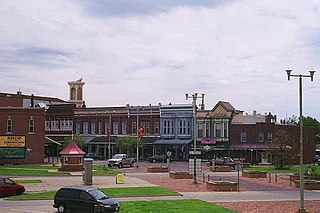
Fort Scott is a city in and the county seat of Bourbon County, Kansas, United States, United States, 88 miles (142 km) south of Kansas City, on the Marmaton River. As of the 2020 census, the population of the city was 7,552. It is the home of the Fort Scott National Historic Site and the Fort Scott National Cemetery. Fort Scott is named for Gen. Winfield Scott.
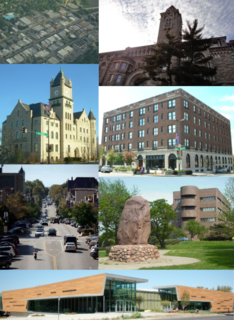
Lawrence is the county seat of Douglas County and sixth-largest city in Kansas. It is in the northeastern sector of the state, astride Interstate 70, between the Kansas and Wakarusa Rivers. As of the 2020 census, the population of the city was 94,934. Lawrence is a college town and the home to both the University of Kansas and Haskell Indian Nations University.
The U.S. state of Kansas, located on the eastern edge of the Great Plains, was the home of nomadic Native American tribes who hunted the vast herds of bison. In around 1450 AD, the Wichita People founded the great city of Etzanoa. The city of Etzanoa was abandoned in around 1700 AD. The region was explored by Spanish conquistadores in the 16th century. It was later explored by French fur trappers who traded with the Native Americans. Most of Kansas became permanently part of the United States in the Louisiana Purchase of 1803. When the area was opened to settlement by the Kansas–Nebraska Act of 1854 it became a battlefield that helped cause the American Civil War. Settlers from North and South came in order to vote slavery down or up. The free state element prevailed.

Bleeding Kansas, Bloody Kansas, or the Border War was a series of violent civil confrontations in Kansas Territory, and to a lesser extent in western Missouri, between 1854 and 1859. It emerged from a political and ideological debate over the legality of slavery in the proposed state of Kansas.

The Territory of Kansas was an organized incorporated territory of the United States that existed from May 30, 1854, until January 29, 1861, when the eastern portion of the territory was admitted to the Union as the free state of Kansas.
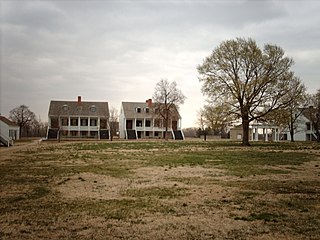
Fort Scott National Historic Site is a historical area under the control of the United States National Park Service in Bourbon County, Kansas, United States. Named after General Winfield Scott, who achieved renown during the Mexican–American War, during the middle of the 19th century the fort served as a military base for US Army action in what was the edge of settlement in 1850. For the next quarter century, it was used as a supply base and to provide security in turbulent areas during the opening of the West to settlement, a period which included Bleeding Kansas and the American Civil War.
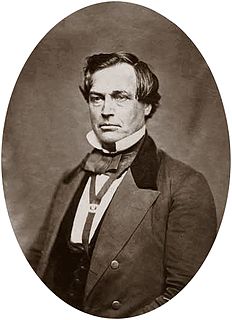
James William "Jim" Denver was an American politician, soldier and lawyer. He served in the California state government, as an officer in the United States Army in two wars, and as a Democratic member of the United States House of Representatives from California. He served as secretary and Governor of the Kansas Territory during the struggle over whether or not Kansas would be open to slavery. The city of Denver, Colorado, is named after him.
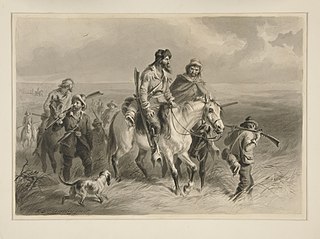
During the events leading to the American Civil War, border ruffians was the derogatory name for proslavery raiders from the slave state of Missouri, who crossed into Kansas Territory to induce violence that peaked from 1854 to 1858 to force the acceptance of slavery.

Jayhawkers and red legs are terms that came to prominence in Kansas Territory, during the Bleeding Kansas period of the 1850s; they were adopted by militant bands affiliated with the free-state cause during the American Civil War. These gangs were guerrillas who often clashed with pro-slavery groups from Missouri, known at the time in Kansas Territory as "Border Ruffians" or "Bushwhackers". After the Civil War, the word "Jayhawker" became synonymous with the people of Kansas, or anybody born in Kansas. Today a modified version of the term, Jayhawk, is used as a nickname for a native-born Kansan, but more typically for a student, fan, or alumnus of the University of Kansas.

The Pottawatomie massacre occurred on the night of May 24–25, 1856, in the Kansas Territory. In reaction to the sacking of Lawrence by pro-slavery forces on May 21, and the severe attack on May 22 on Massachusetts Senator Charles Sumner for speaking out against slavery in Kansas, John Brown and a band of extremist abolitionist settlers—some of them members of the Pottawatomie Rifles—made a violent reply. Just north of Pottawatomie Creek, in Franklin County, they killed five pro-slavery settlers, in front of their families. This soon became the most famous of the many violent episodes of the "Bleeding Kansas" period, during which a state-level civil war in the Kansas Territory was described as a "tragic prelude" to the American Civil War which soon followed. "Bleeding Kansas" involved conflicts between pro- and anti-slavery settlers over whether the Kansas Territory would enter the Union as a slave state or a free state. It is also John Brown's most questionable act, both to his friends and his enemies. In the words of abolitionist Frederick Douglass, it was "a terrible remedy for a terrible malady."
The Wakarusa War was an armed standoff that took place in the Kansas Territory during November and December 1855. It is often cited by historians as the first instance of violence during the "Bleeding Kansas" conflict between anti-slavery and pro-slavery factions in the region.
The timeline of Kansas details past events that happened in what is present day Kansas. Located on the eastern edge of the Great Plains, the U.S. state of Kansas was the home of sedentary agrarian and hunter-gatherer Native American societies, many of whom hunted American bison. The region first appears in western history in the 16th century at the time of the Spanish conquest of Mexico, when Spanish conquistadores explored the unknown land now known as Kansas. It was later explored by French fur trappers who traded with the Native Americans. It became part of the United States in the Louisiana Purchase of 1803. In the 19th century, the first American explorers designated the area as the "Great American Desert."
Cofachique is a ghost town situated along the Neosho River near the present-day city of Iola in Allen County, Kansas, United States. Being the first town established in Allen County in 1855, it was the original county seat. However, within five years the greater part of the town was moved to the new town of Iola, while the old site of Cofachique became farm land. The town was named in honor of an Osage chief known as Cofachique, who is said to have been particularly helpful to early settlers, bringing aid to the distressed and homeless. The name "Cofachique" appears to have origins with the Cofachiqui tribe in South Carolina, who were Siouan speakers, and the Osage who settled this area were closely affiliated with the Siouan.

The Marais des Cygnes Massacre Site, also known as Marais des Cygnes Massacre Memorial Park, is a state historic site near Trading Post, Kansas that commemorates the 1858 massacre of the same name. On May 19, 1858, during a period of political instability and sporadic violence known as Bleeding Kansas, a group of pro-slavery border ruffians captured 11 abolitionist free-staters. The prisoners were forced to a nearby ravine, where 10 of them were shot, resulting in five fatalities. The abolitionist John Brown later built a fort near the site. The first commemoration at the site was two stone markers erected by men of the 3rd Iowa Cavalry Regiment in 1864, although these monuments had been destroyed by souvenir hunters by 1895. In 1941, the land where the massacre occurred, as well as an 1870s-era house constructed by a friend of Brown, were transferred to the state of Kansas. The site was listed on the National Register of Historic Places in 1971 and designated a National Historic Landmark in 1974. The Kansas Historical Society administers the site, which is interpreted by signage and a hand-cranked audio recording.
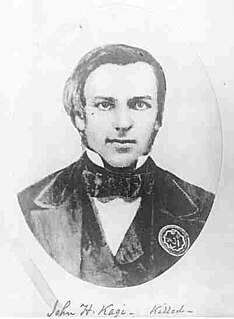
John Henry Kagi, also spelled John Henri Kagi, was an American attorney, abolitionist, and second in command to John Brown in Brown's failed raid on Harper's Ferry. He bore the title of "Secretary of War" in Brown's "provisional government." At age 24, Kagi was killed during the raid. He had previously been active in fighting on the abolitionist side in 1856 in "Bleeding Kansas". He was an excellent debater and speaker.
Samuel Walker was an American soldier, lawman and politician who settled in Lawrence, Kansas and served as an officer during Bleeding Kansas and the American Civil War.
John Allen Wakefield and his family was one of the first settlers to come to the newly created Kansas Territory. Free soilers, they arrived in western Douglas County, Kansas, in July 1854, one month after the territory was opened to settlement. They built a large log house to serve primarily as their living quarters. It had six rooms and was 6 miles (9.7 km) west of the free-state stronghold of Lawrence, Kansas. For protection the family built loop holes for guns into the sides of the house.

Samuel Jefferson Jones was a pro-slavery settler who held the position of Douglas County sheriff in Kansas Territory from late 1855 until early 1857. He helped found the territorial capital of Lecompton and played a prominent role in the "Bleeding Kansas" conflict.